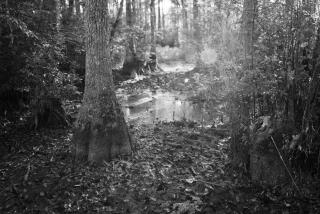The Finest One-Volume Civil War Ever Written : BATTLE CRY OF FREEDOM The Civil War Era<i> by James M. McPherson (Oxford University Press: $30 until July 1</i> ; <i> $35 thereafter; 904 pp</i> .<i> , illustrated, plus maps) </i>
- Share via
Deep South slave-holders, Prof. James M. McPherson tells us, sang and danced in the streets of Charleston, Savannah and New Orleans once Abraham Lincoln had been inaugurated President. No closet Republicans come out of hiding, these planters were frolicking because their state governments, in bristling recoil from the new Administration’s opposition to slavery, had stalked out of the Union and slammed the door. Assuming safety in secession from Yankee meddling with their “way of life,” the dancers giddily dismissed the looming possibility of a civil war. Besides, people said that even were it to come to that, a lady’s thimble would hold all the blood that would be spilt.
Sixteen hundred blood-drenched days later, the South was a smoking ruin, and 620,000 Confederate and Union men and boys were dead. A single day’s battle (Antietam) had cost America quadruple the casualties it would later sustain at Normandy Beach; the enormity of one naval defeat stood unchallenged until Pearl Harbor. But at war’s end, the nation, preserved by its resolute President, could substantiate its 90-year-old promise of liberty and justice for all. Those dancing now were the 4 million newly liberated slaves.
Deftly coordinated, gracefully composed, charitably argued and suspensefully paid out, MacPherson’s book is just the compass of the tumultuous middle years of the 19th Century it was intended to be, and as narrative history it is surpassing. Bright with details and fresh quotations, solid with carefully-arrived-at conclusions, it must surely be, of the 50,000 books written on the Civil War, the finest compression of that national paroxysm ever fitted between two covers.
The all-American war flared as the climax of a succession of localized ranklings and quarrels that had vexed the nation throughout the preceding decade. Southern slavery, that estranging issue, particularly the subissue of expansion of slavery into new states and territories, seemed most especially to defy rational solution, for slavery’s proponents asserted adamantly that the right to own property carried with it the right to own property that was human.
Indeed, no matter how morally estimable they might otherwise be, many Southern gentry, economically beholden to slave labor, could not--or would not--concede the speciousness of their position. Congressional compromises, Supreme Court rulings, vilifying debates between Democrats and the so-called Black Republicans, canings and fisticuffs in the U.S. Senate, one-sided preachments from pulpits and pressrooms, and, eventually, shootings and head-cleavings among Kansans and Missourians addressed, but did not resolve the standoff.
And honor . . . always someone’s Southern honor being sullied when Yankees refused to return runaway slaves to their owners.
President James Buchanan might say that secession would prove nothing except “conclusively that men were unfit for self government,” but by that time Southerners were resorting to the hopeless illogic of a Texas broadside that declared “freedom is not possible without slavery.” At such an Orwellian juncture as that, there was probably no stopping that first Confederate cannonball that thunked defiantly into the brick battlements of the U.S. Army’s Ft. Sumpter at 4:30 a.m., April 12, 1861.
No wonder, either, that soldiers North and South, convinced their cause was the more righteous, could adopt and sing, with only slightly different lyrics, a martial ditty called “Battle Cry of Freedom.”
By the end of the first third of his book, McPherson has drawn, in involving style, a vivid portrait of antebellum America: disparate but essential textbook facts woven together and coaxed into color by the actions and observations of those most affected. Thereafter, he recounts with equally memorable accents the interacting events of the war itself: the shifting political tides of patriotic unity and potential treachery that washed through North and South; the draining economic, social and personal costs to the civilian despairs and rejoicings in Richmond and in Washington as the fortunes of battle--controlled sometimes by grand strategies, sometimes by the accidental finding of a lost enemy document--tilted first one way and then another.
And throughout, McPherson seems to have picked out the richest of the copiously rich Civil War material. No soldier anywhere has more succinctly portrayed battlefield Angst than the Yankee who said, “When bullets are whacking against tree trunks, . . . between the physical fear of going forward and the moral fear of turning back, there is a predicament of exceptional awkwardness.” No Commander in Chief can more daintily express exasperation than the Lincoln who scolded temporizing advisers: “Elder-stalk squirts, charged with rose water” will never save the Union.
Woodrow Wilson, a Virginian, would later say, “Because I love the South, I rejoice in the failure of the Confederacy.” But as McPherson tells it, the war’s outcome was in doubt almost until the very end.
Historians, he says, cannot prove--as some have striven to do--that the Yankees won and the Rebels lost because of the relative disparity in resources of money and manpower. Nor that the South eventually abandoned its will to win. Nor that the North had superior military leadership. There are no such easy explanations.
All, says McPherson, “lack the dimension of contingency--the recognition that at numerous critical points during the war things might have gone altogether differently. . . . The war cannot be understood apart from the contingency that hung over every campaign, every battle, every election, every decision” during its course.
Readers of “Battle Cry of Freedom” will experience the full dimension of these contingent episodes and will perfectly well understand the Civil War at the end of McPherson’s expertly fashioned book.
More to Read
Sign up for our Book Club newsletter
Get the latest news, events and more from the Los Angeles Times Book Club, and help us get L.A. reading and talking.
You may occasionally receive promotional content from the Los Angeles Times.










